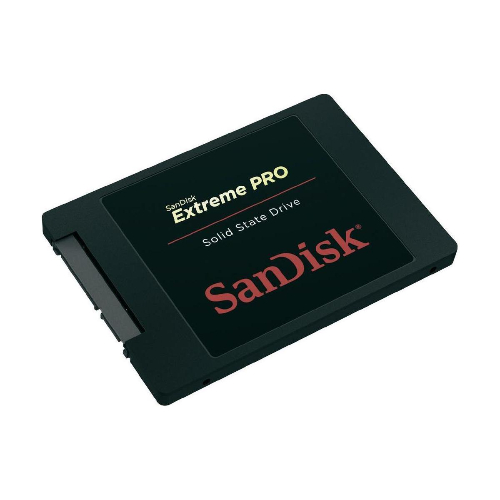SanDisk May Be Clearing Extreme Pro SSD Inventory Ahead Of New Release
The SanDisk Extreme Pro SSD currently sits at the top of every High-Performance SATA slot in our Best SSDs of 2015 ranking. The drive is an amazing performer that retains its high performance even under extreme load. Because of that, we've chosen it over Samsung's 850 Pro that can lose performance after heavy use. The Extreme Pro has everything you would expect to find in a workstation SSD, so seeing them at mid-level prices gets us excited.

For the last several days, we've seen the prices plummet on Extreme Pro SSDs. The 480 GB model appears to be the best value, with prices dipping down to $165 at more than one etailer. The 240 GB drive has been as low as $65, but we were not able to find that price when we wrote this article. Currently, the Extreme Pro 960 GB sells for $330, around $30 more than many of the new very low-cost TLC-based SSDs that make up the entry-level, but $15 less than the 850 EVO, the product that all entry level SSDs are compared to.
Clearing Out Inventory?
The last time SanDisk was aggressive with an Extreme Series SSD was nearly two years ago with the Extreme II. Extreme II prices had the same sudden and large price drop off prior to the Extreme Pro launch. There was a one- to two-month window to purchase an Extreme II at low price levels before warehouse stock depleted.
It's reasonable to assume that SanDisk has a new flash weapon ready to display at CES 2015. We've talked to people deep inside the company and heard a few rumors about what may come to market. SanDisk's new high-performance SSD could be two new models that utilize 15nm lithography. The first should be a new SATA 6 Gb/s model to replace the Extreme Pro. The second is a bit more interesting.
Using Fusion-IO IP?
It's long been rumored that SanDisk will release a new client-based SSD using Fusion-IO technology, which SanDisk acquired in 2014. Fusion-IO is no stranger to client SSDs; in 2009, the company released the ioXtreme (MSRP $895) and ioXtreme Pro (MSRP $1,499) for high-performance enthusiasts and power users. The drives never gained popularity with users due to high cost and the inability to boot Windows off of the drives as the primary storage volume.
The drives used Xilinx FPGA controllers over a PCIe 2.0 x4 interface to deliver up to 700 MB/s of sequential read performance. In 2009, flash was very expensive. Since then, lithography shrinks have reduced the cost of flash, and Fusion-IO controllers have also increased in performance in that time. The Xilinx FPGA controller used on the ioXtreme featured 25 channels with a dedicated channel to ECC. Modern Fusion-IO SSDs scale to 6.4 TB in capacity and deliver significantly more performance than those released in 2009.
It will be interesting to see what SanDisk cooks up for the annual CES BBQ that is just a few months away. Until then, we just have to live with very low cost Extreme Pro SSDs. We're not going to turn that down.
Get Tom's Hardware's best news and in-depth reviews, straight to your inbox.
Chris Ramseyer is a Contributing Editor for Tom's Hardware, covering Storage. Follow him on Twitter and Facebook. Follow Tom's Hardware on Twitter, Facebook and Google+.
-
priya mani That's a great news about a new release of SanDisk Pro SSd, which gives more benefits to the people.Reply
Geethapriya - SgbcIndia, Join our digital revolution -
Olaf_Metal The Ultra II is also selling low at $105 for the 480 gb. The premium for PCI drives over SATA always seemed a bit excessive to me and it seems like their would be room to sell a PCI drive at a disruptive price if a manufacturer was willing to cannibalize their sata sales. Maybe Sandisk will be the first to make that leap.Reply -
CRamseyer I wouldn't expect a low cost drive coming from the Fusion-IO side. 20+ channel controllers are expensive to buy and manufacture. Its in the same class as the Intel SSD 750.Reply
The low cost drives on the market now use 4-channel designs. -
oyoy Looks like Sandisk starting to shape there profiles as the pioneers in SSD prices for costumers. Because I'm happy, after the The Ultra II 960GB $200, I'm happy, clap along if you feel like that's what you wanna do... :)Reply -
beetlejuicegr ReplyCould care less. SanDisk has done some pretty nasty crap to their customers.
Yeah well on the other hand i still have a generation 2 sandisk ssd which got the trim option through firmware (imagine how old :) ) and is still kicking fine ^^ -
Brandon_29 My favorite deal going on right now is the Rosewill Quark-1000 Platinum power supply on newegg.Reply
139.99+40 rebate. Even without the rebate the price is great and with it the price is amazing.
http://www.newegg.com/Product/Product.aspx?Item=N82E16817182353
I have purchased a dozen or so Rosewill full modular power supplies and all of them have worked flawlessly to date. They are a bit stiff, but not as bad as some others. -
JonDol Hi there, You meant CES 2016 not 2015 did you? Would be also nice to see if it could be considered for the next system builder marathon...Reply
Regards -
The Preying Mantis Is true. Went to Best Buy to buy a SSD and was super surprised to find a 240gb Sandisk SSD for around $60 compared to a 250gb Samsung SSD for almost double. No brainer purchase, especially for the project I'm using it for.Reply
